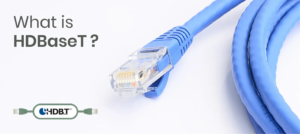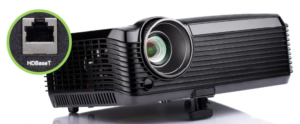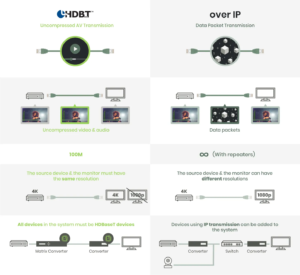
What Is HDBaseT?
HDBaseT is a connectivity standard for the transmission of uncompressed high-definition multimedia content, as well as various other signals, over a single Cat5e/6 cable. The name “HDBaseT” stands for High-Definition Base-T, emphasizing its focus on high-quality video and audio transmission. HDBaseT is commonly used in audio-video (AV) applications, such as home theaters, digital signage, and professional installations.
Release
HDBaseT is an uncompressed transmission technology developed by HDBaseT Alliance, the association grouped by Samsung, LG, Sony Picture, and Valens. After its release in 2010, HDBaseT 2.0 was published in 2013, and HDBasetT 3.0 in 2019.

Benefits of HDBaseT Extension
The core technology HDBaseT 5Play can integrate AV, Ethernet, power, data, and control signals and pass them down through one category cable, extending them for 100m. Category cables HDBaseT used are also less expensive and accessible.
As HDMI and DisplayPort progressed in AV transmission, they could only pass by audio and video signals within a limited distance. When it comes to the connection of several devices, the drawback of short transmission distance and the inability to carry control signals and power make it less possible. The release of HDBaseT brought solutions to the problem.

HDBaseT 5Play

- For HDBaseT 2.0 and above, 5Play includes:
- Video and audio
- USB 2.0
- Control signals
- Power
- Ethernet
Video and Audio
For professional needs, HDBaseT 1.0 can support 4K 30Hz uncompressed video. HDBaseT 2.0 combines audio and video in 5Play and supports S/PDIF and I²S audio input. Moreover, till HDBaseT 3.0, it can transmit 4K 60Hz video.

Ethernet
At first, HDBaseT used the 100Base-T network standard. HDBaseT 3.0 now supports the 1000Base-T standard, with a data transfer rate of up to 1Gbps.
Control Signals
Controls via IR, RS232 and CEC are supported.
Power
Power over HDBaseT (PoH) can transmit power over the same category cable rather than another power line, making cabling easier.
USB 2.0
A new member of 5Play that supports data transmission and provides the ability to connect to USB devices.
HDBaseT Standards
The below table shows the specifications of different HDBaseT versions. HDBaseT cable must be Cat5e and above; Cat6a is recommended for use.
| HDBaseT 1.0 |
HDBaseT 2.0 |
HDBaseT 3.0 |
|
| Minimum Requirement |
Cat5e | Cat6 | |
| Recommended Cable |
Cat6 | Cat6a, Fiber | |
| Resolution | 4K@30Hz | 4K@60Hz | |
| Audio | from HDMI | from HDM, S/PDIF, I²S | |
| Ethernet Data Rate |
100Mbps | 1Gbps | |
| Control Signal | IR、RS232、CEC | ||
| Power | 100W | ||
|
USB |
N/A | USB 2.0 | |
HDMI vs. HDBaseT
HDBaseT aims to resolve problems arising from HDMI transmission. In addition to improvements in distance and signals transmitted, there is more to be noted.
Resolution
The picture quality makes no big difference in HDBaseT or HDMI. Both support 4K 60Hz high resolution and are suitable for both professional and household use. Though HDMI 2.0 supports 8K resolution, the technologies they adopt make a distinction. HDMI uses lossless compression for better transfer efficiency, while HDBaseT delivers uncompressed video via category cables that are ideal for transmission. For industries that require accurate pictures, uncompressed video provides real scenes to prevent mistakes.
Interchangeability
As HDMI has a much higher market share than HDBaseT and most devices do not have an HDBaseT output interface, HDMI and HDBaseT can be interchanged across a wide range of devices to avoid the dilemma of devices not working properly.
It is worth noting that since HDMI transmission includes only audio and video, it cannot pass down IR, RS232, and enough power through HDMI cables when converted from HDBaseT. Usually, devices have interfaces for control so users can connect the device using other cables.
HDBaseT Devices
As mentioned, HDBaseT can be applied to AV devices on the receiver side, such as monitors and projectors. In contrast, it cannot be used for devices on the transmitter side due to technical limitations. If multiple signals, including AV, are to be integrated into HDBaseT, the relevant encoder will be necessary.

Best AV Transmission Technology
To sum up, HDBaseT has the following benefits:
- Easily accessible and cheaper category cables allow more data and power to be transmitted and save space.
- Transmission distance is longer than HDMI, DisplayPort, and other conventional AV interfaces, allowing multi-connection with other devices.
- Support 4K 60Hz HDR for excellent picture quality.
- That’s why HDBaseT is considered the best technology available today for AV transmission.
HDBaseT Applications

Remote Education
Demands for remote learning are rapidly growing. Via HDBaseT, a PTZ camera can be controlled remotely and present actual teaching scenes from every angle. The lecturer, the projected teaching materials, and the interaction in the class can all be captured by the camera and presented to online students.


Healthcare Environments
PACS (Picture Archiving and Communication System) makes the transmission and storage of medical images easier. After the equipment is examined and processed by the medical staff, uncompressed images can be rapidly transmitted via HDBaseT to a medical imaging workstation, distributed to clinics, and stored in the database through the network.


HDBaseT vs. HDMI over IP: What’s the Difference
HDMI Over IP and HDBaseT
AV over IP, or HDMI over IP, may be more common than HDBaseT when it comes to the technologies of AV transmission. Most AV transmission depends on Ethernet since Ethernet devices are extensive, such as online streaming devices, broadcast equipment, telephones, and network devices.
As HDBaseT revolves around 5Play to develop its transmission technology, HDBaseT and HDMI over IP are used for different purposes. Below are some comparisons.
Transmission
HHDMI over IP is data packet transmission, whereas HDBaseT transmits audio and video signals. You cannot use an HDMI over IP device in HDBaseT systems, and vice versa. While IP transmission is lossless compression, HDBaseT delivers uncompressed AV signals, which is more suitable for those projects in need of uncompressed, no-latency images.
Distance
HDBaseT extends transmission for a maximum of 100 meters, which is a limitation for larger projects. HDMI over IP systems, on the other hand, can be extended for a much longer distance over network cables whenever a repeater is added.
Flexibility
Both can provide 4K picture quality, but HDBaseT cannot adjust the resolution based on the device used. That means if you need one 4K display, other displays in the system must also be 4K. In contrast, HDMI over IP is adjustable between displays with different resolutions.
Expandability
HDBaseT devices must be made using Valens chips, and when expanding an HDBaseT AV system, you can only add HDBaseT displays and devices. HDMI over IP, instead, can be expanded by adding any IP devices, creating more possibilities for expansion in the future.
Cost
Though no license fees are required for producing HDBaseT equipment, Valens chips are relatively expensive, and thus so does the equipment. As manufacturers need to be licensed for HDMI products, the expense can vary based on their specifications, components, etc. Hence, what comes first is not the cost but the requirement when people consider building an AV system.
Comparison
| HDMI over IP | HDBaseT | |
| Cables | HDMI cables | Category cables |
| AV Transmission | Lossless compression | Uncompressed |
| Distance | Limitless with repeaters | 100m or more with repeaters |
| Display Resolution | Adjustable for display resolutions | Displays must have the same resolution |
| Expandability | Expandable | Less expandable |

Comparisons of AV Transmission Technologies
We believe it is important to understand their specifications to determine the most suitable technology and solution for each project. We summarize the specifications of some common AV transmission technologies in the table below.
| HDMI 2.1 | DisplayPort 2.0 | HDBaseT 3.0 | AV over IP | |
| Bandwidth | 48Gbps | 80Gbps | 16Gbps (same as HDMI 2.0) | Depends on the equipment. |
| Distance | 5~10 m | 100 m | Limitless | |
| Power | Power can be transferred to HDMI devices |
No | Maximum 100W | Depends on the PoE specifications of the equipment. |
| Control | Control of HDMI displays, projectors, and players via CEC |
No | Support control via IR, RS232, and CEC | |
| USB Transmission | No | USB-C DP Alt mode | USB 2.0 | Up to USB 3.0 |
| Daisy Chain | No | Yes | ||
| Strengths and Uses |
High market share, suitable for most home and commercial AV installations |
Suitable for most home and commercial AV installations. better refresh rate than HDMI. support USB-C |
Uncompressed, no-delay signals; AV, network, and control signals over one cable; long expansion distance | Highly expandable and flexible; ideal for use in commercial buildings and large projects; compatible with nearly all IP devices. Encoders and decoders can transmit almost every signal. |
Conclusion
In summary, HDBaseT and HDMI over IP are both viable solutions for AV signal distribution, but they cater to different needs. HDBaseT is known for its simplicity and dedicated point-to-point connection, while HDMI over IP provides greater flexibility and scalability over existing network infrastructure. The choice between them depends on the specific requirements of the installation.

Hi there, I enjoy reading all of your article
post. I like to write a little comment to support
you.
Hi there,
Thank you for reaching out, and I’m delighted to hear that you enjoyed our recent blog article! It’s always gratifying to know that our content resonates with our readers.
We strive to provide valuable insights and information on various AV topics, and it’s wonderful to hear that you found it enjoyable and informative. Your positive feedback encourages us to continue creating content that adds value to our audience.
If you have any further thoughts, questions, or suggestions for future topics you’d like us to cover, please don’t hesitate to let us know. We’re always eager to hear from our readers and to tailor our content to meet their interests and needs.
Once again, thank you for taking the time to read our blog article and for reaching out with your kind words. We truly appreciate your support!
Best regards,
Steven G